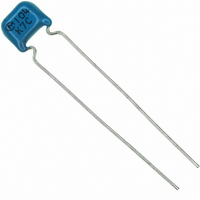RDER72J104K8K1C11B Murata Electronics North America, RDER72J104K8K1C11B Datasheet - Page 17

RDER72J104K8K1C11B
Manufacturer Part Number
RDER72J104K8K1C11B
Description
CAP CER 100000PF 630V X7R RADIAL
Manufacturer
Murata Electronics North America
Series
RDEr
Datasheets
1.RPEF51H104Z2K1A03B.pdf
(2 pages)
2.RDEE41H104M0K1C03B.pdf
(3 pages)
3.RDER72J682K2K1C11B.pdf
(39 pages)
4.RDER72J104K8K1C11B.pdf
(1 pages)
Specifications of RDER72J104K8K1C11B
Capacitance
0.1µF
Voltage - Rated
630V
Tolerance
±10%
Temperature Coefficient
X7R
Mounting Type
Through Hole
Operating Temperature
-55°C ~ 125°C
Features
High Voltage
Applications
General Purpose
Package / Case
Radial
Size / Dimension
0.217" L x 0.295" W (5.50mm x 7.50mm)
Thickness
4.00mm Max
Lead Spacing
0.197" (5.00mm)
Lead Style
Flat Bent
Lead Free Status / RoHS Status
Lead free / RoHS Compliant
Ratings
-
Other names
490-4821
Available stocks
Company
Part Number
Manufacturer
Quantity
Price
Company:
Part Number:
RDER72J104K8K1C11B
Manufacturer:
PANASONIC
Quantity:
30 000
!Note
• This PDF catalog is downloaded from the website of Murata Manufacturing co., ltd. Therefore, it’s specifications are subject to change or our products in it may be discontinued without advance notice. Please check with our
• This PDF catalog has only typical specifications because there is no space for detailed specifications. Therefore, please approve our product specifications or transact the approval sheet for product specifications before ordering.
sales representatives or product engineers before ordering.
!Note
No.
10
RPE Series Small Size, Large Capacitance Specifications and Test Methods
1
2
3
4
5
6
7
8
9
Operating Temperature
Range
Appearance
Dimension and Marking
Dielectric
Strength
Insulation
Resistance
Capacitance
Dissipation Factor (D.F.)
Capacitance
Temperature
Characteristics
Terminal
Strength
Vibration
Resistance
• Please read rating and !CAUTION (for storage, operating, rating, soldering, mounting and handling) in this catalog to prevent smoking and/or burning, etc.
• This catalog has only typical specifications because there is no space for detailed specifications. Therefore, please approve our product specifications or transact the approval sheet for product specifications before ordering.
Item
Between
Terminals
Body
Insulation
Between
Terminals
Tensile
Strength
Bending
Strength
Appearance No defects or abnormalities
Capacitance Within the specified tolerance
D.F.
-55 to +125˚C
No defects or abnormalities
See previous pages
No defects or abnormalities
No defects or abnormalities
500M · F min.
Within the specified tolerance
0.025 max.
Within T15%
Termination not to be broken or loosened
Termination not to be broken or loosened
0.025 max.
Specifications
Specifications and Test Methods
Visual inspection
Visual inspection, Vernier Caliper
The capacitor should not be damaged when DC
voltage of 250% of the rated voltage is applied
between the terminations for 1 to 5 sec.
(Charge/Discharge current V 50mA)
The capacitor is placed in a
container with metal balls of 1mm
diameter so that each terminal,
short-circuit, is kept approximately
2mm from the balls as shown in
the figure, and 250% of the rated
DC voltage is impressed for 1 to 5
sec. between capacitor terminals
and metal balls.
(Charge/Discharge current
V 50mA)
The insulation resistance should be measured with a
DC voltage not exceeding the rated voltage at normal
temperature and humidity and within 2 min. of
charging.
(Charge/Discharge current V 50mA)
The capacitance/D.F. should be measured at the
frequency of 1T0.1kHz and a voltage of
AC1T0.2V(r.m.s.)
The capacitance change should be measured after
5 min. at each specified temperature stage.
As in the figure, fix the capacitor body, apply the force
gradually to each lead in the radial direction of the
capacitor until reaching 10N and then keep the force
applied for 10T1 sec.
Each lead wire should be subjected to a force of 2.5N
and then bent 90˚ at the point of egress in one
direction. Each wire is then returned to the original
position and bent 90˚ in the opposite direction at the
rate of one bend per 2 to 3 sec.
The capacitor should be firmly soldered to the
supporting lead wire and vibrated at a frequency range
of 10 to 55Hz, 1.5mm in total amplitude, with about a 1
minute rate of vibration change from 10Hz to 55Hz and
back to 10Hz. Apply for a total of 6 hrs., 2 hrs. each in 3
mutually perpendicular directions.
Step
1
2
3
4
5
F
Test Method
Continued on the following page.
–
Temperature (˚C)
125T3
-55T3
25T2
25T2
25T2
Approx. 2mm
Metal balls
C49E.pdf
15
10.3.8
2






















